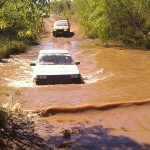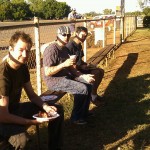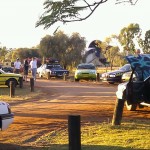Today we started the real rally; that is, there was a point we reached today where it stopped being a road trip and became a journey. I’m writing this, dripping wet, from the veranda of the Heartbreak Hotel in the Northern Territory after what can only be described as an epic day on the dirt.
We started from the Hells Gate roadhouse in the far northwestern corner of Queensland and headed west across the NT border along the Savannah Way. It’s marked on the map as a major road, but is is impassable for half the year due to the rivers that cut across it, draining the flat savannah lands of northern QLD and NT into the Gulf of Carpentaria. Our original route would have hugged the edge of the Gulf, crossing seven rivers, but had to be changed because these were still running too high to be forded safely. Instead, we were to head inland on the Calvert road after two smaller river crossings.
The previous day from Gregory Downs up onto the Savannah Way and west to Hells Gate had taught us some valuable lessons on what not to attempt with ancient shitboxes on dirt roads. Firstly, if you hit sand, front wheel drive cars will go wombat and dig a burrow if you don’t keep your speed up. Unfortunately, and secondly, wide trenches will appear through the dust left behind by the car in front with almost no notice, so it becomes a fine line between keeping speed up and getting no chance of negotiating hazards. Thirdly, if you hit a pothole hard enough in an ’87 Camry with no shock absorbers the onboard fuel injection computer will assume you have just crashed into a wall and shut the engine down. Finally, an oncoming thirty ton fully laden road train on a gravel road beats eight shitboxes coming the other way. Every time.
Having survived the trip to Hells Gate with only a single oh-no-we-are-out-of-the-rally moment (see point three above), we set off cautious but optimistic, which lasted as long as the first river crossing when we arrived through a sooty haze of grass fires to a queue of cars waiting to attempt to get across. It happens that there is a magic combination of speed, revs, route and blind luck that decides whether your shitbox sails across or makes like a sub. We were lucky three times, and were whizzing along through pasture land on a crazy switchback track until we encountered crossing number four. This one was different: there were no support vehicles (they were still pulling shitboxes out of the previous crossing) and there was a telltale line of stationary vehicles on the other side oozing water.
Now, we had reason to believe that we were fated to make Darwin when on the previous day we lost the oil cap due to not getting it back on right and chanced upon a weed infested wreck of an ancient Toyota van in the back of the roadhouse that had a cap that was a perfect fit. Fate deserted us two thirds of the way across the river, when the bow wave broke over the bonnet and the engine stalled. We threw our already attached tow rope to the guys on the bank but it was too late… the carpets began to lift as the water level (which was mid way up the door on the outside) began to rise in the car. By the time we were towed clear of the river we were sitting in a foot of brown river water, saturating everything. Even worse, water had gotten into the engine, potentially a rally-ender.
We travel in buddy groups of about ten cars. Three in our group are Camrys, and all three were sitting, sad and soggy, at the edge of the road, unable to start. Byron, from Stinkeroos, gave us our marching orders and we began the long process of drying out the engine, air intake filter, and onboard computer. It took two hours of patient cajoling of the venerable machines but our team and the Stinkeroos managed to finally get the engines turning over again. There is no finer sound in the world than the first time a waterlogged Camry engine two hundred and fifty kilometres from the nearest proper road turns over.
This presented us with another problem. To keep the revs up and flush the crap out of the engine, the idle rev rate was set to 2500 rpm. For an automatic transmission, this is exactly the same as setting cruise control for 80km/h and then not being able to turn it off. On dirt roads full of shitboxes in low visibility.
We went like hell, using the UHF radio to contact the guys in front to pull over to the side and let our crazed convoy through. We were quite literally unstoppable; I slammed on the brakes to avoid a large hole in the road only to go into a massive set of fishtails in the gravel, struggling to bring the car under control as we slid from bank to bank and back again. And then just as suddenly, the dirt track gave way to a perfectly graded gravel road stretching across the vast, treeless prairie of the Barkly Tablelands. Maintaining speed safely was no longer a problem for us but for the Stinkeroos, whose coil set had partially shorted out from the water leaving them with just two operating cylinders, speed was becoming an issue. As the sun went down in spectacular fashion, and after an aborted effort to tow the Stinkeroos the remaining 170km to base, Byron hatched a plan to share the cables three each between the Camrys, leaving us both with three out of four cylinders firing and just enough poke to roll into the Heartbeat Hotel wet, tired and sore an hour and a half after sunset.
So, so far, the ’87 Camry with very little suspension has survived over 3,000km of driving on roads of all conditions, potholes, river crossings, engine flooding and finally cylinder tinkering. Will it make Darwin? I think it just might be fate after all.










